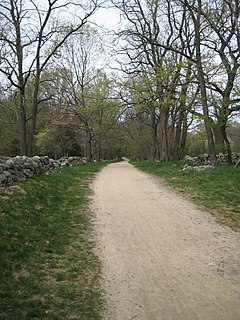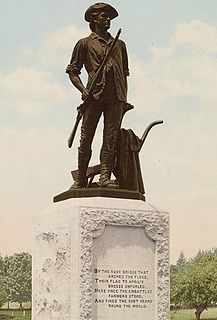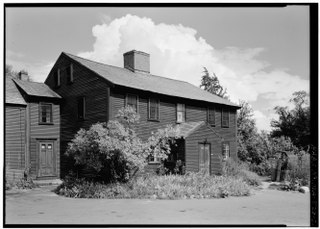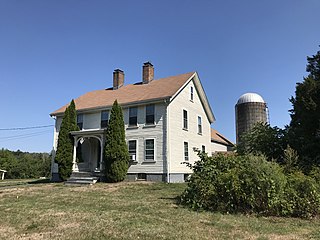
Samuel Prescott was an American physician and a Massachusetts Patriot during the American Revolutionary War. He is best known for his role in Paul Revere's "midnight ride" to warn the townspeople of Concord, Massachusetts of the impending British army move to capture guns and gunpowder kept there at the beginning of the American Revolution. He was the only participant in the ride to reach Concord.

The North Bridge, often colloquially called the Old North Bridge, is a historic site in Concord, Massachusetts, spanning the Concord River. On April 19, 1775, the first day of the American Revolutionary War, provincial minutemen and militia companies numbering approximately 400 engaged roughly 90 British Army troops at this location. The battle was the first instance in which American forces advanced in formation on the British regulars, inflicted casualties, and routed their opponents. It was a pivotal moment in the Battles of Lexington and Concord and in American history. The significance of the historic events at the North Bridge inspired Ralph Waldo Emerson to refer to the moment as the "shot heard round the world."

The Wayside is a historic house in Concord, Massachusetts. The earliest part of the home may date to 1717. Later it successively became the home of the young Louisa May Alcott and her family, who named it Hillside, author Nathaniel Hawthorne and his family, and children's writer Margaret Sidney. It became the first site with literary associations acquired by the National Park Service and is now open to the public as part of Minute Man National Historical Park.

Minute Man National Historical Park commemorates the opening battle in the American Revolutionary War. It also includes the Wayside, home in turn to three noted American authors. The National Historical Park is under the jurisdiction of the National Park Service and protects 970 acres (392.5 ha) in and around the Massachusetts towns of Lexington, Lincoln, and Concord.

The Battles of Lexington and Concord were the first military engagements of the American Revolutionary War. The battles were fought on April 19, 1775, in Middlesex County, Province of Massachusetts Bay, within the towns of Lexington, Concord, Lincoln, Menotomy, and Cambridge. They marked the outbreak of armed conflict between the Kingdom of Great Britain and its thirteen colonies in America.

The Col. James Barrett Farm is a historic American Revolutionary War site in Concord, Massachusetts, associated with the revolution's first battle, the 1775 battles of Lexington and Concord. His farm was the storage site of all the town of Concord's militia gunpowder, weapons and two pairs of prized bronze cannons.

Battle Road, formerly known as the Old Concord Road and the Bay Road, is a historic road in Massachusetts, United States. It was formerly part of the main road connecting Lexington, Lincoln and Concord, three of the main towns involved in the American Revolutionary War. It was on Battle Road that thousands of colonial militia and British regulars fought during the redcoats' retreat from Concord to Boston on the morning and afternoon of April 19, 1775.

The Signer's House and Matthew Thornton Cemetery are a pair of historic properties in Merrimack, New Hampshire, United States. It consists of a house, once owned by Matthew Thornton, a signer of the United States Declaration of Independence, and the adjacent cemetery in which he is buried. The house is a two-story Georgian style double house, and is the only surviving house of the period in Merrimack. It was owned by Thornton from 1780 to 1797, when he sold it to his son James. The cemetery, located across the Daniel Webster Highway from the house, is also Merrimack's first cemetery, with the oldest gravestone marked 1742.
Capt. John Trull (1738–1797) was the commander of the Tewksbury, Massachusetts minuteman company on the first day of the American Revolution, at the Battle of Lexington & Concord.

Hartwell Tavern is a historic American Revolutionary War site associated with the revolution's first battle, the 1775 battles of Lexington and Concord. It is located on North County Road, just off Battle Road in Lincoln, Massachusetts, and operated as a historic house museum by the National Park Service as part of the Minute Man National Historical Park. Built in 1733, in what was then Concord, it is staffed from Memorial Day (May) weekend to October by park rangers dressed in colonial attire who offer programs daily.

The Minute Man is an 1874 sculpture by Daniel Chester French in Minute Man National Historical Park, Concord, Massachusetts. It was created between 1871 and 1874 after extensive research, and was originally intended to be made of stone. The medium was switched to bronze and it was cast from ten Civil War-era cannons appropriated by Congress.

The Samuel Hartwell House is a historic American Revolutionary War site associated with the revolution's first battle, the 1775 battles of Lexington and Concord. Built around 1694, in what was then Concord, it was located on North County Road, just off Battle Road in today's Lincoln, Massachusetts, and about 700 feet east of Hartwell Tavern, which Hartwell built for his son, Ephraim, and his newlywed wife, Elizabeth, in 1733. The site is part of today's Minute Man National Historic Park.

The Captain William Smith House is a historic American Revolutionary War site in Lincoln, Massachusetts, United States. Part of today's Minute Man National Historic Park, it is associated with the revolution's first battle, the 1775 battles of Lexington and Concord. Believed to have been built in 1692, in what was then Concord, it is believed to be the oldest house in Lincoln.

The Job Brooks House is a historic American Revolutionary War site in Lincoln, Massachusetts, United States. It is part of today's Minute Man National Historic Park.

The Jacob Whittemore House is a historic American Revolutionary War site in Lexington, Massachusetts, United States. It is part of today's Minute Man National Historic Park. It is located on Airport Road, just off Battle Road. It is the only house of the "witness" houses of the April 19, 1775 battles of Lexington and Concord to fall inside the Lexington town line; the others are in Lincoln or Concord.

The Samuel Brooks House is a historic American Revolutionary War site in Concord, Massachusetts, United States. It is part of today's Minute Man National Historic Park. It is located on North Great Road, just off Battle Road.
The Bloody Angle refers to a section of the Battle Road, in Lincoln, Massachusetts, on which two battles were fought on April 19, 1775, during the battles of Lexington and Concord in the first stage of the American Revolutionary War. The stretch of the mainly east–west–running road turns north for about 500 yards (460 m) and then east, as per the direction of travel during the British regulars' retreat from nearby Concord to Boston.

The Nathan Meriam House is a historic American Revolutionary War site associated with the revolution's first battle, the 1775 battles of Lexington and Concord. Built around 1705, it stands on Old Bedford Road, near its intersection with Lexington Road, in Concord, Massachusetts; the intersection is now known as Meriam's Corner. It is one of eleven houses within the Minute Man National Historic Park that still exists today. This area was part of the former Battle Road.

The Farwell Jones House is a historic American Revolutionary War site associated with the revolution's first battle, the 1775 battles of Lexington and Concord. Built in the early 18th century, it stands on Lexington Road in Concord, Massachusetts, just southwest of the former Battle Road. It is one of eleven houses within the Minute Man National Historic Park that still exists today.

The Noah Brooks Tavern is a historic American Revolutionary War site associated with the revolution's first battle, the 1775 battles of Lexington and Concord. It stands, on the site of a previous home, on North Great Road in Lincoln, Massachusetts, just south of the former Battle Road, in an area known as Brooks Village. It is one of eleven houses within the Minute Man National Historic Park that still exists today.


















